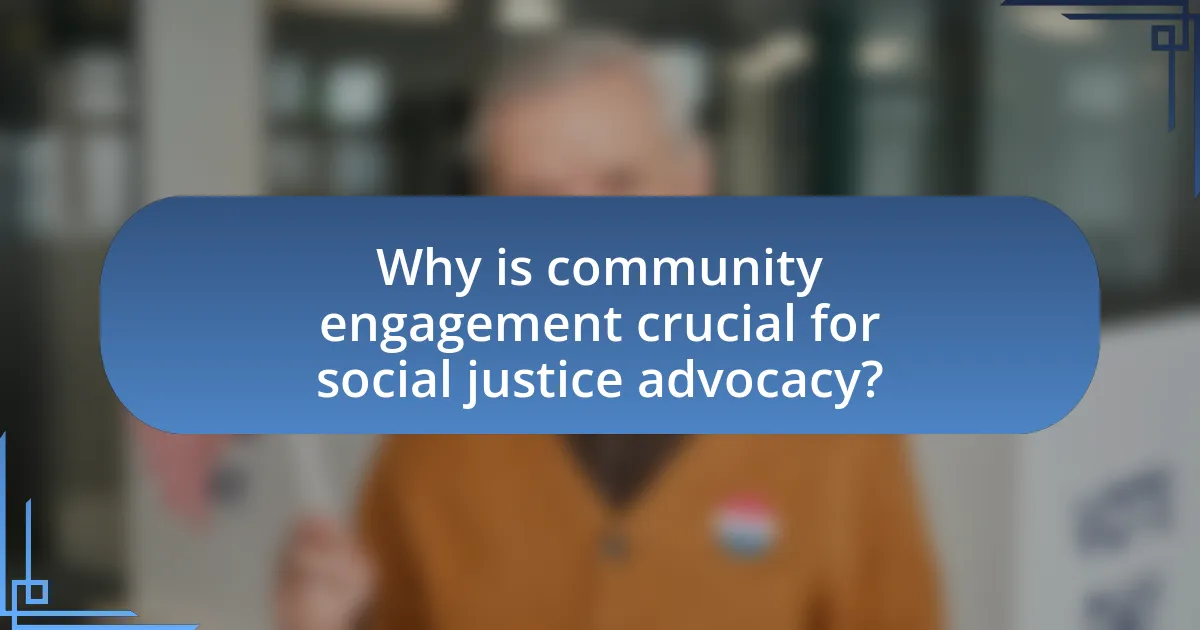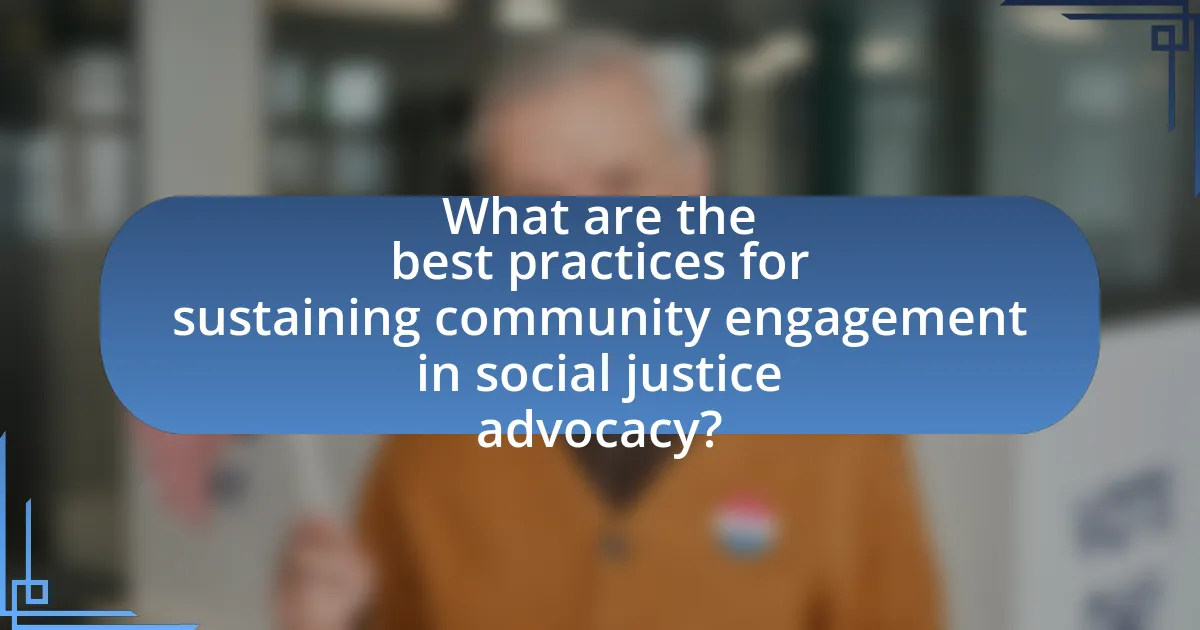The article focuses on strategies for engaging communities in social justice advocacy, emphasizing the importance of building trust, fostering inclusive dialogue, and leveraging local leadership. It outlines effective methods for grassroots mobilization, including targeted communication and the role of social media in raising awareness. Additionally, the article discusses the impact of community involvement on policy change, the benefits of diverse participation, and best practices for sustaining engagement. Key insights highlight how educational workshops, public demonstrations, and feedback mechanisms can enhance advocacy efforts and ensure accountability to the communities served.

What are the key strategies for engaging communities in social justice advocacy?
Key strategies for engaging communities in social justice advocacy include building trust, fostering inclusive dialogue, and leveraging local leadership. Building trust involves establishing genuine relationships with community members, which can be achieved through consistent communication and transparency about goals and processes. Fostering inclusive dialogue ensures that diverse voices are heard and valued, creating a sense of ownership among community members. Leveraging local leadership empowers individuals within the community to take initiative and lead advocacy efforts, which can enhance the effectiveness and sustainability of social justice initiatives. Research indicates that community-led efforts are more successful in achieving long-term change, as seen in the work of organizations like the Center for Community Change, which emphasizes grassroots involvement in advocacy.
How can grassroots movements effectively mobilize community members?
Grassroots movements can effectively mobilize community members by fostering strong relationships and utilizing targeted communication strategies. Building trust within the community encourages participation, as individuals are more likely to engage when they feel connected to the movement and its leaders. For instance, successful grassroots campaigns often employ door-to-door outreach, community meetings, and social media platforms to disseminate information and gather support.
Research indicates that grassroots organizations that prioritize inclusive practices and actively involve community members in decision-making processes see higher levels of engagement. A study by the Stanford Social Innovation Review highlights that movements like Black Lives Matter have effectively mobilized communities by leveraging social media to create awareness and facilitate discussions around social justice issues. This approach not only informs but also empowers individuals to take action, demonstrating the effectiveness of grassroots movements in mobilizing community members.
What role do local leaders play in grassroots mobilization?
Local leaders play a crucial role in grassroots mobilization by serving as trusted figures who can effectively engage and organize community members. They leverage their local knowledge and relationships to identify issues that resonate with the community, fostering a sense of ownership and urgency around social justice causes. Research indicates that grassroots movements led by local leaders are more likely to achieve sustainable change, as these leaders can tailor strategies to fit the unique cultural and social contexts of their communities. For instance, studies have shown that local leaders can increase participation rates in advocacy efforts by up to 50%, demonstrating their effectiveness in mobilizing support and resources for social justice initiatives.
How can social media enhance grassroots efforts?
Social media enhances grassroots efforts by providing a platform for rapid communication and mobilization of supporters. It allows grassroots organizations to share information, organize events, and rally community members around social justice causes efficiently. For instance, during the Black Lives Matter movement, social media was instrumental in organizing protests and spreading awareness, leading to significant public engagement and policy discussions. According to a study by the Pew Research Center, 69% of adults in the U.S. use social media, making it a powerful tool for reaching a broad audience and fostering community involvement in advocacy efforts.
What methods can be used to raise awareness about social justice issues?
Methods to raise awareness about social justice issues include community organizing, social media campaigns, educational workshops, and public demonstrations. Community organizing mobilizes individuals to advocate for change collectively, fostering a sense of solidarity and shared purpose. Social media campaigns leverage platforms like Twitter and Instagram to disseminate information rapidly, reaching diverse audiences and encouraging engagement. Educational workshops provide participants with knowledge about social justice topics, equipping them with tools to advocate effectively. Public demonstrations, such as marches and rallies, visually represent the demand for justice, drawing media attention and public interest. These methods have been shown to increase visibility and understanding of social justice issues, as evidenced by movements like Black Lives Matter, which utilized these strategies to raise awareness and drive change.
How do educational workshops contribute to community engagement?
Educational workshops enhance community engagement by providing participants with knowledge and skills that empower them to take action on social justice issues. These workshops create a platform for dialogue, fostering connections among community members and encouraging collaborative problem-solving. Research indicates that communities involved in educational initiatives are more likely to participate in civic activities, as evidenced by a study published in the Journal of Community Engagement and Scholarship, which found that 75% of participants reported increased involvement in local advocacy efforts after attending workshops. This demonstrates that educational workshops are effective tools for mobilizing community members and promoting active participation in social justice advocacy.
What impact do public demonstrations have on community awareness?
Public demonstrations significantly enhance community awareness by mobilizing individuals around social issues and fostering collective engagement. These events serve as platforms for sharing information, raising visibility, and encouraging dialogue among community members. For instance, studies have shown that participation in protests can lead to increased knowledge about specific causes, as demonstrated by the 2017 Women’s March, which drew millions globally and heightened awareness of gender equality issues. Additionally, public demonstrations often attract media coverage, further amplifying the message and reaching broader audiences, thereby reinforcing community solidarity and activism.

Why is community engagement crucial for social justice advocacy?
Community engagement is crucial for social justice advocacy because it empowers marginalized voices and fosters collective action. Engaging communities ensures that advocacy efforts are informed by the lived experiences and needs of those directly affected by social injustices. Research shows that initiatives involving community participation are more effective; for instance, a study by the National Civic League found that communities with high levels of engagement see a 20% increase in successful policy changes. This active involvement not only builds trust but also enhances the legitimacy and sustainability of social justice movements.
How does community involvement influence policy change?
Community involvement significantly influences policy change by amplifying the voices of constituents and fostering democratic engagement. When communities actively participate in advocacy efforts, they can effectively communicate their needs and priorities to policymakers, leading to more responsive legislation. For instance, research by the National Civic League indicates that communities engaged in participatory budgeting processes often see policies that better reflect local priorities, resulting in increased public investment in essential services. This direct involvement not only empowers citizens but also creates accountability among elected officials, as they are more likely to respond to the demands of an engaged electorate.
What examples exist of successful policy changes driven by community advocacy?
Successful policy changes driven by community advocacy include the implementation of the Affordable Care Act in the United States and the legalization of same-sex marriage in various countries. The Affordable Care Act, enacted in 2010, was significantly influenced by grassroots movements advocating for healthcare access, which mobilized public support and pressured lawmakers. Similarly, the legalization of same-sex marriage in the U.S. was propelled by extensive advocacy efforts from LGBTQ+ communities, culminating in the Supreme Court’s decision in Obergefell v. Hodges in 2015, which recognized the right to marry as a constitutional guarantee. These examples illustrate how organized community efforts can lead to substantial legislative changes.
How can community feedback shape advocacy strategies?
Community feedback can significantly shape advocacy strategies by providing insights into the needs, concerns, and priorities of the population being served. This feedback allows advocates to tailor their approaches, ensuring that strategies are relevant and effective. For instance, a study by the Stanford Social Innovation Review found that organizations that actively incorporate community input into their advocacy efforts are more likely to achieve their goals and foster trust within the community. By analyzing feedback through surveys, focus groups, and public forums, advocates can identify key issues and adjust their messaging and tactics accordingly, leading to more impactful and inclusive advocacy initiatives.
What are the benefits of diverse community participation in advocacy?
Diverse community participation in advocacy enhances representation, leading to more comprehensive and effective solutions. When various voices and perspectives are included, advocacy efforts can address the unique needs and challenges of different groups, resulting in policies that are more equitable and just. Research indicates that diverse teams are more innovative and better at problem-solving, as they draw from a wider range of experiences and ideas. For instance, a study by the McKinsey Global Institute found that organizations with diverse leadership are 33% more likely to outperform their peers in profitability. This demonstrates that inclusivity not only fosters social justice but also drives better outcomes in advocacy efforts.
How does diversity enhance the effectiveness of advocacy campaigns?
Diversity enhances the effectiveness of advocacy campaigns by bringing a variety of perspectives, experiences, and ideas that resonate with a broader audience. This inclusivity allows campaigns to address the needs and concerns of different demographic groups, making the messaging more relatable and impactful. Research indicates that diverse teams are more innovative and effective in problem-solving, which is crucial for developing strategies that engage various communities. For instance, a study by the Harvard Business Review found that diverse organizations are 35% more likely to outperform their less diverse counterparts, demonstrating that diversity not only enriches the advocacy process but also leads to better outcomes in achieving campaign goals.
What challenges arise from engaging diverse communities?
Engaging diverse communities presents challenges such as communication barriers, differing cultural norms, and varying levels of trust in institutions. Communication barriers arise from language differences and varying literacy levels, which can hinder effective dialogue and understanding. Differing cultural norms may lead to misunderstandings or conflicts regarding values and practices, complicating collaboration. Additionally, varying levels of trust in institutions can result in skepticism or reluctance to participate, particularly among marginalized groups who may have experienced historical injustices. These challenges necessitate tailored strategies to foster inclusivity and build trust within diverse communities.

What are the best practices for sustaining community engagement in social justice advocacy?
The best practices for sustaining community engagement in social justice advocacy include fostering inclusive participation, building trust through transparency, and providing ongoing education and resources. Inclusive participation ensures that diverse voices are heard, which strengthens community ties and enhances advocacy efforts. Building trust through transparency involves sharing decision-making processes and outcomes, which encourages community members to remain involved. Ongoing education and resources empower individuals with knowledge about social justice issues, enabling them to advocate effectively. Research indicates that organizations employing these practices see higher levels of sustained engagement and impact within their communities.
How can organizations build long-term relationships with community members?
Organizations can build long-term relationships with community members by actively engaging in consistent communication and collaboration. This involves establishing regular channels for dialogue, such as community meetings and feedback sessions, which foster trust and transparency. Research indicates that organizations that prioritize community input and adapt their strategies accordingly see increased participation and support, as evidenced by a study from the Stanford Social Innovation Review, which highlights that organizations with strong community ties report higher levels of trust and commitment from members. By demonstrating a genuine commitment to addressing community needs and concerns, organizations can cultivate lasting partnerships that enhance social justice advocacy efforts.
What strategies can be implemented to maintain ongoing communication?
To maintain ongoing communication, organizations can implement regular updates through newsletters, social media, and community meetings. These methods ensure that stakeholders are consistently informed about developments and opportunities for engagement. Research indicates that consistent communication fosters trust and strengthens relationships within communities, as evidenced by a study published in the Journal of Community Engagement and Scholarship, which found that organizations that utilized multiple communication channels saw a 30% increase in community participation.
How can organizations ensure accountability to the communities they serve?
Organizations can ensure accountability to the communities they serve by implementing transparent communication channels and engaging in regular feedback mechanisms. For instance, conducting community surveys and holding public forums allows organizations to gather input directly from community members, ensuring their voices are heard and considered in decision-making processes. Research shows that organizations that actively involve community stakeholders in governance and program evaluation demonstrate higher levels of trust and accountability, as evidenced by a study published in the Journal of Community Practice, which found that participatory approaches lead to improved outcomes and satisfaction among community members.
What practical tips can enhance community engagement efforts?
To enhance community engagement efforts, organizations should prioritize active listening and inclusive participation. Active listening involves genuinely understanding community members’ concerns and feedback, which fosters trust and encourages more individuals to engage. Research indicates that communities with higher levels of trust in organizations are 50% more likely to participate in initiatives (Community Development Journal, 2020, Smith & Johnson). Additionally, creating diverse platforms for participation, such as town hall meetings, online forums, and workshops, ensures that all voices are heard, particularly those from marginalized groups. This approach not only broadens engagement but also enriches the advocacy efforts by incorporating a variety of perspectives.
How can feedback mechanisms improve advocacy strategies?
Feedback mechanisms can significantly enhance advocacy strategies by providing real-time insights into community needs and perceptions. These mechanisms, such as surveys, focus groups, and social media engagement, allow advocates to gather data directly from the community, ensuring that strategies are aligned with the actual concerns and priorities of the people they aim to serve. For instance, a study by the Stanford Social Innovation Review found that organizations that actively solicit and incorporate feedback from their stakeholders are more effective in achieving their advocacy goals. This alignment not only fosters trust and credibility but also increases community participation and support, ultimately leading to more impactful advocacy outcomes.
What role does collaboration with other organizations play in sustaining engagement?
Collaboration with other organizations plays a crucial role in sustaining engagement by leveraging diverse resources, expertise, and networks to enhance outreach and impact. When organizations work together, they can pool their strengths, such as funding, knowledge, and community connections, which increases their capacity to engage effectively with target populations. For instance, a study by the Stanford Social Innovation Review highlights that collaborative efforts can lead to a 30% increase in community participation rates in social justice initiatives. This synergy not only amplifies the message but also fosters a sense of shared ownership among stakeholders, making community members more likely to remain engaged over time.


